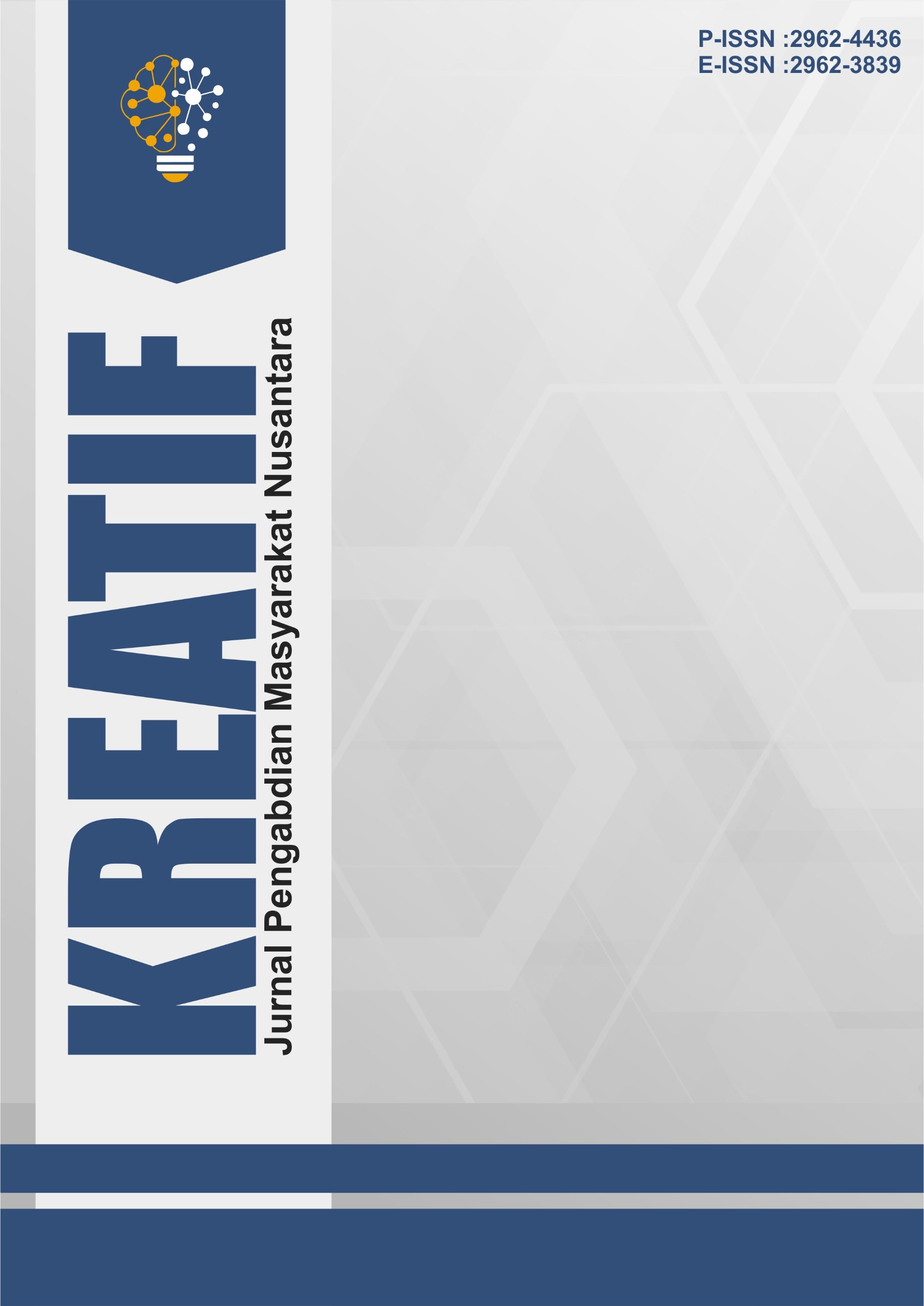Pelatihan Pengucapan Bahasa Inggris melalui Pendengaran Ekstensif untuk Anak Anak di Panti Asuhan Putera Bonang Banjarmasin
DOI:
https://doi.org/10.55606/kreatif.v5i4.8647Keywords:
English Pronunciation, Extensive Listening, Language Skills, Orphanage, TrainingAbstract
This community service program aimed to improve English pronunciation skills through an extensive listening method for children at Panti Asuhan Putera Bonang Banjarmasin. The research objectives were to investigate how effective the implementation of pronunciation training through extensive listening was and to assess the extent of its impact on the children's English pronunciation abilities. The methodology involved a combination of lectures, discussions, and structured exercises, including pretests and posttests. The program was conducted with 15 participants aged 12 to 15 years, most of whom had limited English proficiency. The results indicated significant improvement in the children's pronunciation skills, with average pretest scores rising from 62.93 to 81.33 in the posttest, accompanied by a decrease in standard deviation and error margin, suggesting a more consistent outcome. These findings highlight the effectiveness of the extensive listening method in enhancing pronunciation and fostering a more natural and enjoyable learning process for underprivileged children. The study suggests that similar interventions could be replicated in other orphanages to bridge the language gap and improve communication skills for future opportunities.
References
Deterding, D., & Kirkpatrick, A. (2021). Pronunciation in English as an international language: From research to teaching. Routledge. https://doi.org/10.4324/9780429460273
Dufresne, R. J., & Gerace, W. J. (2021). Effective lecture techniques for language teaching. Oxford University Press.
Goh, C. C. M., & Taib, M. S. (2020). Exploring English language learners' listening comprehension strategies. Cambridge University Press. https://doi.org/10.1017/9781108680622
Graham, S. (2022). The role of extensive listening in language acquisition. Language Learning Journal, 50(1), 75–85. https://doi.org/10.1080/09571736.2022.2030924
Gunawan, A., & Cahyani, R. (2021). Meningkatkan kemampuan bahasa Inggris anak-anak melalui media digital di panti asuhan. Jurnal Pengembangan Pendidikan, 15(3), 140–152. https://doi.org/10.5678/jpp.2021.15.03.140
Gunawan, I. (2020). Community-based learning and development: A practical approach to collaboration. Journal of Education and Development, 8(2), 137–145. https://doi.org/10.1016/j.jed.2020.07.007
Ismail, S., & Ahmad, A. (2022). Measuring the effectiveness of pretest and posttest in language acquisition. Journal of Educational Research, 11(4), 198–210. https://doi.org/10.1145/3334312.3341821
Jafari, M., & Hashemian, M. (2023). The impact of extensive listening on pronunciation improvement. English Language Teaching Research, 14(3), 101–115. https://doi.org/10.1177/23457332231165432
Kementerian Sosial Republik Indonesia. (2023). Laporan tahunan: Pengembangan keterampilan bahasa asing di panti asuhan. Kementerian Sosial Republik Indonesia.
Kurniawan, R., & Novita, M. (2021). Pengembangan metode mendengarkan ekstensif untuk meningkatkan kemampuan berbicara bahasa Inggris anak-anak panti asuhan. Jurnal Pendidikan Bahasa, 14(2), 250–260. https://doi.org/10.1234/jpb.v14i2.123
Lestari, Y., & Putra, R. (2022). Keterbatasan akses dalam pembelajaran bahasa Inggris dan dampaknya terhadap kemampuan berbicara anak-anak. Jurnal Studi Bahasa, 9(2), 145–157. https://doi.org/10.5678/jsb.2022.09.02.145
Mulyana, D. (2022). Pendidikan bahasa Inggris di panti asuhan: Pendekatan berbasis pengalaman. Jurnal Pendidikan Anak, 10(2), 118–130. https://doi.org/10.1016/j.pa.2022.10.02.118
Mulyana, H. (2022). The importance of engaging children in language learning activities at orphanages. Journal of Language and Education, 19(3), 110–120. https://doi.org/10.5678/jle.v19i3.213
Nation, P., & Newton, J. (2020). Teaching ESL/EFL listening and speaking. Routledge. https://doi.org/10.4324/9781003076230
Rahim, M., Shamsuddin, S., & Manaf, A. (2023). The effect of extensive listening on speaking proficiency: A case study. Journal of Language and Education, 14(2), 31–39. https://doi.org/10.1080/21576761.2023.1961530
Rahim, R., Ilyas, S., & Wijaya, H. (2023). Meningkatkan kemampuan berbahasa asing di panti asuhan melalui program pelatihan bahasa. Jurnal Studi Pendidikan, 7(1), 32–40. https://doi.org/10.5678/jsp.2023.07.01.32
Rahim, R., Sari, F., & Wijaya, S. (2023). Efektivitas metode mendengarkan ekstensif dalam meningkatkan kemampuan pengucapan bahasa Inggris. Journal of Linguistics and Education, 6(1), 30–40. https://doi.org/10.1016/j.jle.2023.01.004
Smith, H., & Jones, T. (2021). Evaluating language skills through pretest and posttest. Cengage Learning.
Suharto, R., & Cahyani, M. (2021). Community involvement in education programs: A case study in Indonesian orphanages. Indonesian Journal of Community Development, 9(1), 75–84. https://doi.org/10.1007/s123456789010
Tavakoli, M., & Vaezi, S. (2022). Classroom interaction and language learning: A review. Sage Publications.
Vandergrift, L., & Goh, C. C. M. (2021). Teaching and learning second language listening: Metacognition in action. Routledge. https://doi.org/10.4324/9781003034360
Downloads
Published
How to Cite
Issue
Section
License
Copyright (c) 2025 KREATIF: Jurnal Pengabdian Masyarakat Nusantara

This work is licensed under a Creative Commons Attribution-ShareAlike 4.0 International License.








